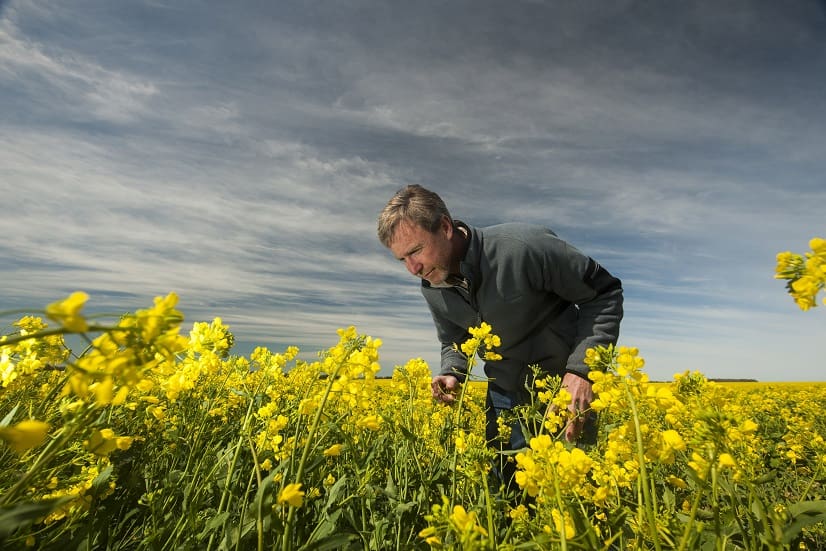
Steve Marcroft
CANOLA growers in the southern cropping region are being encouraged to closely monitor crops for signs of blackleg infection in the upper canopy to avoid costly yield loss this season.
Upper canopy infection (UCI) occurs in the flowers, peduncles, pods, upper main stem and branches and has become increasingly prevalent over the past 10 years, possibly due to crops flowering earlier because of the earlier sowing of suitable cultivars and more rapid phenological development during warmer autumns and winters.
UCI can cause yield losses of 20-40 per cent and management primarily centres on selecting cultivars with effective major gene resistance and using crop management strategies to delay the commencement of flowering to later in the growing season.
Since 2016, the Grains Research and Development Corporation (GRDC) has invested in research to better understand the factors contributing to UCI and potential control strategies.
In a recently released GRDC video, ‘Managing upper canopy blackleg infection’ (see below), coordinator of the GRDC’s national canola pathology program, Marcroft Grains Pathology principal Steve Marcroft, said crops flowering in late July and early August were at a much higher risk of developing UCI than those flowering later in August.
It’s believed the UCI risk is greater in crops that are likely to flower in mid to late winter when conditions can be cold and wet, favouring blackleg infection.
“Additionally, through targeted GRDC investment, we are beginning to realise that it isn’t just the growth stage of the plant that’s important when the infection occurs, it’s also the timing of the year,” Dr Marcroft said.
“If the infection occurs later in the year, there’s simply not enough time for the disease to permeate the plant and cause damage to the vascular system which limits moisture uptake to developing pods.
“Preliminary work undertaken by Susie Sprague at CSIRO suggests the disease needs a minimum number of days from infection to harvest to enter the vascular tissue, cause damage and block the plant’s moisture uptake.
“So, you can still get the disease occurring later in the season but it’s relatively superficial to yield loss.”
Ongoing research
The precise number of days required between infection and harvest and the resulting effect on yield under different growing conditions is being investigated in ongoing research.
According to Dr Marcroft, the change in farming systems over the past 10 years has meant crops are flowering much earlier – in the past, crops were vegetative in the mid to late winter period whereas now they tend to be reproductive.
“When they were vegetative, we were seeing leaf lesions which led to crown cankers but once crops are in the reproductive growth stage, it’s more common to see direct infection on the flowers, stems and branches,” he said.
Fungicide application
Dr Marcroft said research suggested that if UCI infection occurred, fungicides used to control Sclerotinia were also likely to reduce UCI severity and yield losses.
“Application of registered products containing prothioconazole and tebuconazole (i.e. Prosaro®) or Aviator® Xpro (Bixafen and Prothioconazole) for Sclerotinia control around 30 per cent bloom can also provide protection from blackleg infection during early flowering,” Dr Marcroft said.
“The 30 per cent bloom spray may control flower, peduncle, stem and branch infections but it is unlikely to provide pod protection.
“High levels of pod infection tend to occur in seasons with frequent late rainfall events, such as 2016, or where there is physical damage to the pods from hail.”
Plan ahead
Growers are encouraged to plan ahead for their fungicide requirements with forecast wet weather in southern grain growing regions likely to put pressure on supplies. Growers should also keep in mind that alternative registered fungicide products such as Procymidone and Iprodione may need to be considered.
While the recent research work has demonstrated the effectiveness of fungicides to largely control UCI in flowers, peduncles, stems and branches, it did not always deliver yield returns.
Dr Marcroft said in some situations, the economic response was large, with 20-30pc yield increases but in other cases, the return was negligible.
To determine the probability of economic response to fungicides, he encouraged growers to look for new leaf lesions occurring up the canopy and also at the commencement date of flowering.
“If lesions are present and flowering commences prior to mid-August then the probability of yield loss from UCI is greatly increased,” he said.
“In future we hope to be able to provide more reliable regionally specific flowering risk dates. For instance, if harvest occurs in October, the risk will be less than if harvest occurs in December, as the December harvest provides more time for the pathogen to invade the pant and damage the vascular tissue prior to harvest.”
Source: GRDC
For more information on blackleg seed treatments, stubble management and fungicide resistance download a copy of Dr Marcroft’s 2020 GRDC Update paper at https://bit.ly/30cHbjH.
The BlacklegCM management app can also assist growers and advisers determine the best and most profitable management strategy to reduce blackleg disease and increase profits. To access the app go to https://bit.ly/2P6ywca.

Has been our policy to disc chain our canola stubble as soon as harvest is over, this reduces the spread of pathogens from spreading. Is this our best management strategy??.